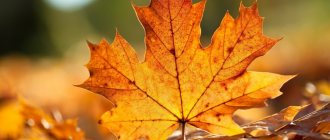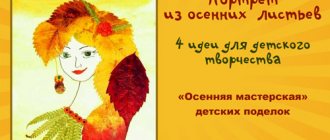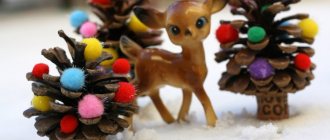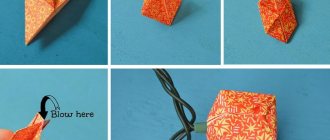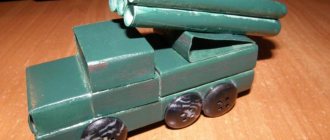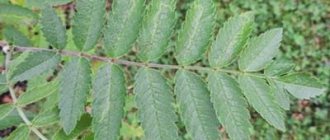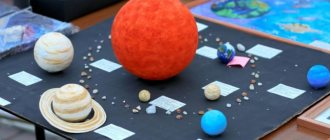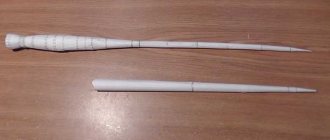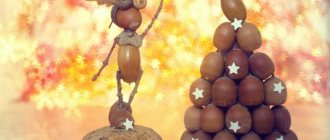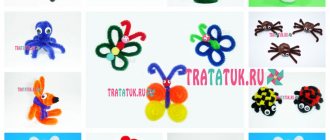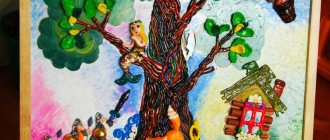Making a hedgehog from leaves
The most important material for our painting is autumn leaves; you and your child will find them in abundance in city gardens and parks.
Choose those that you like, however, but narrow, sharp leaves are best suited for crafts. Pay attention to oak and rowan. At home, rinse our natural material thoroughly, then dry thoroughly
If there is not enough time, then iron the leaves with an iron, they will become smooth and beautiful.
Next we prepare the basis for our application. There are several ways to do this. The easiest option is to find an image of a hedgehog on the Internet, print the picture and stick it on cardboard. Remember that the image should be black and white, because children will love coloring their forest dweller. If you are good at drawing, then you can draw a hedgehog yourself.
To further develop your son or daughter’s fine motor skills, draw an outline on a piece of paper and ask them to cut it out. Additionally, outline the outline of the figure with a brown felt-tip pen so that it is bright and clear. Always focus on the age of your baby and the skills that he has or, conversely, those that need development.
When our foundation is ready, it's time to begin the most interesting and enjoyable part of our work. Spread the hedgehog's body with glue and begin to carefully glue the autumn leaves-needles. You shouldn’t limit your child’s creativity; let him realize his ideas and fantasies. After our hedgehog acquires its prickly coat, the application will need to be put aside for a while to allow the glue to dry thoroughly.
To prevent your child from getting bored, invite him to think about how you will further decorate your work. Show him pictures of an autumn forest or watch a funny cartoon where the main character is a funny prickly animal. When the sheet has dried and there is no chance of damaging the already created craft, we proceed to the final, decorative stage of the work. First, we paint the face and give it a certain expression. Our hedgehog made of leaves can smile or, on the contrary, frown with its drawn eyebrows. Imagine with your child, come up with a story about where the forest dweller is running and what he is carrying. Draw him the apples and mushrooms that he drags into the hole. You can also recreate a forest or clearing. If you have leaves left, you can make trees using the applique technique. Don’t forget that the sun should be shining in the sky and white clouds should be floating.
Our autumn craft made from natural materials is ready, all that remains is to figure out how to hang it on the wall. Using fallen leaves, you can make not only a hedgehog, but also other animals or plants.
Autumn crafts made from natural materials are an important part of lessons on work and the surrounding world in the lower grades of school, and older kindergarten groups are sure to devote some time to them every year. The most popular materials are leaves, twigs and acorns. It's better to stock up on them in advance. Since most often (and especially in kindergartens) autumn crafts begin with applications, the leaves must be well dried.
This is done like this: the collected leaves are straightened and placed between the pages of a thick book with matte, loose pages that absorb moisture well (multi-volume Soviet collected works of general secretaries are perfect). Remember that the pages of the books will look a little distorted and warped after drying, and the leaves will not remain exactly as bright as they were when you picked them from the ground. The colors always fade slightly. This effect can be slightly weakened by additionally lining each sheet with tissue paper, but not by much. And remember - the longer the leaf dries, the duller it looks.
Try to space the leaves several pages apart. It will take you at least a week to dry them, so go to a park or square with your child at the very beginning of autumn.
Preparing leaves for work
Before you start making anything, it is important to prepare the leaves. This is because many of them are dirty and can cause unnecessary waste in the future. And the product will not look particularly neat if it is dirty.
First of all, the raw materials for work must be washed under a gentle stream of warm water. Then the leaves should be laid out to dry, and a little later, put away in some thick book.
They should smooth out to make the job a little easier.
Ideas for inspiration
Yellow leaf bird:
Printable bird:
Simple paper crafts
A few more printable templates:
Just give free rein to your imagination and follow the step-by-step photo instructions.
Pictures made from autumn leaves are a wonderful craft and good entertainment for children and parents. For any medium-sized picture, occupying about three-quarters of an A4 sheet, you will need a lot of leaves, at least 20-30 pieces, and a variety of them.
Collect them with your children in early autumn and dry them - you can use a special press for this, but the easiest way is to put the leaves in books (but, firstly, these should either be books you don’t really need, because drying even leaves among the pages spoils them a little these pages, or place the leaves between sheets of tissue or plain paper.
And, secondly, put these books in a visible place or remember them in some other way, because the leaves in the book are easy to “lose” in the home library). Drying usually takes 1-2 weeks, even if the leaves you picked were not fresh, but already slightly wilted.
If there is any damage on the leaves (for example, a few holes from insects), this is completely normal; such leaves can also be dried and used in crafts.
In the process of collecting and creating the application itself, you can additionally tell children about what kind of leaves they are, what trees they are, their features, etc.; creative work that develops motor skills and imagination can also be educational.
How to store and transport
Soda ash is stored and transported in special disposable containers or bags made of polypropylene. Transportation is carried out by all types of transport, there are no special restrictions. But it should not be exposed to direct sunlight or moisture, so the soda must be securely closed during transportation. It should also be stored closed; the room should not be damp and should have large windows through which rays can fall on the container with soda.
We suggest you familiarize yourself with How to clean a carpet with soda: cleaning a carpet with soda and vinegar, cleaning a carpet at home
What do you need for work?
Whatever application option is chosen, you will definitely need maple leaves, which must be collected and dried. There are two ways to properly dry the leaves: place the leaves between the pages of the book, it is better to lay each leaf with a paper napkin, or place the leaves on sheets of paper, cover with another sheet of paper and iron. In addition, you need to purchase sheets of cardboard, preferably colored, plasticine, glue, paints and brushes, scissors.
It is important to remember that no matter where the child makes appliqués, at home or at school, for example, if it is 1st grade and the child is just learning how to make crafts, you need to teach the child to prepare a workplace before starting work; it is best to cover the work surface with oilcloth. Before you begin the process of gluing the leaves, you need to think through the plot of the future painting, then select the necessary leaves and arrange them according to your plan
The leaf is always glued first - the base, for example, for a hedgehog - this is the body, then additional leaves. It is better to apply glue to the edges of the leaf, and not to the middle, so that the leaf does not become deformed during drying; the finished picture can be placed under a press and a frame can be made for it
Before you begin the process of gluing the leaves, you need to think through the plot of the future painting, then select the necessary leaves and arrange them according to your plan. The leaf is always glued first - the base, for example, for a hedgehog - this is the body, then additional leaves. It is better to apply glue to the edges of the leaf, and not to the middle, so that the leaf does not become deformed during drying; the finished picture can be placed under a press and a frame can be made for it.
Leaf fall in the room
Leaf fall is one of the most beautiful autumn phenomena. Only it is very fleeting. You can make an amazing craft when the leaves are spinning all the time in the air.
This product will look elegant in the bedroom or in the kitchen above the table. Falling leaves in the house will create an extraordinary feeling of warmth and autumn comfort.
Craft a wreath of maple leaves
You can combine a wreath of maple leaves with many other natural materials:
- Bunches of rowan
- Cones
- Spruce branches
To create such a wreath you will need time and perseverance, as well as available materials:
- Willow twigs, wire or any other available base for the frame
- Scotch tape or thread
How to make a wreath from maple leaves:
- First make a round base from willow twigs or hard wire
- After this, twist each maple leaf onto the base with its tail.
- To keep the leaves in place, secure them with thin wire or thread
- Add decorations as you weave the wreath
Another option for a wreath base is cardboard.
:
- Cut out a ring from cardboard
- Carefully wrap the circle with knitting thread
- After which you can start decorating the wreath with leaves, fixing them with PVA glue
Young woman
- First, a blank is printed or drawn;
- Autumn leaves are attached like a girl's hair;
- The resulting craft is decorated with pencils, paints or felt-tip pens
Think about how else to decorate this product using your imagination.
Now you know how to make crafts from leaves yourself and you can keep your child busy with this. If he goes to 1st grade, this information will be incredibly useful for him, because now at school the child will be able to show all his skills and express himself by creating an amazing application.
Video Children's autumn crafts from leaves
Autumn gives us not only a harvest of vegetables, fruits and berries, but also a large number of dry leaves of a wide variety of colors and shades, which gives us the opportunity to show our imagination and use them for joint creativity with children or to create some kind of decoration for the interior of our home.
In addition, in order to engage in this type of activity, practically no financial investments are required (with the exception of glue and cardboard) - dry leaves lie under your feet, collect as much as you want. And how much joy and positive emotions your child will receive if you entrust him with this important task.
Maple leaves are especially popular for autumn crafts, since the shape of its leaves and beautiful colors allow them to be used in a wide variety of applications. In general, you can make a huge number of crafts from autumn leaves - it all depends on your imagination, but today we will focus on one of them, namely the applique called “hedgehog made from natural maple leaves,” or rather, its most interesting variations.
Progress:
Step 1: Cut out a hedgehog template from paper
Step 2 Start gluing the leaves
Step 4: Glue all the leaves onto the hedgehog's back .
Step 5: Paint the hedgehog's nose and eye with black gouache.
Our “ Hedgehog from autumn leaves ”
Crafts from autumn leaves A magical, beautiful and fragrant time of year has arrived - autumn. She sneaks up quietly and unnoticed. Autumn breeze and slight coolness.
Photo report “Appliqués from autumn leaves” One of the favorite types of visual arts for children is appliqué. Working with natural materials is accessible to preschool children.
Where to begin
Regardless of which appliqué technique you choose, there is a certain procedure that must be followed. First, natural material must be collected. You need to choose whole, undamaged leaves of a wide variety of colors. Then the leaves should be dried. There are two main technologies for drying leaves:
- Place each sheet separately between the pages of an old book;
- Carefully iron each sheet placed between two sheets of paper with a warm iron.
Choose the method you like best. Next, let's prepare our workplace: cover the table with oilcloth, take sheets of paper or cardboard, PVA glue and scissors and felt-tip pens.
If you are creating an application together with a small child, it is better to use fresh leaves and then dry the entire finished composition. In other cases, after preparing (harvesting and drying) the natural material, you can come to the most interesting thing - creating the image of your future application. After choosing the main idea of the painting, you should prepare the necessary leaves and arrange them on the sheet in accordance with your creative idea. First, we need to glue the base of the future figure onto our background - for the hedgehog, the base will be its torso. Other leaves will be attached to it. Do not apply glue to the entire sheet
, otherwise after drying the craft will become uneven. After all the dried leaves are glued, the application is placed under a press, for example, in an old thick book for two to three days.
How to work with the material correctly
If you just collect all the foliage you like on the street, then the bouquet made from it will not last long. Over time, the leaves will dry out and shrink, and the bouquet will darken and become unsightly. There are two options to preserve the autumn composition for a long time.
- Preparing leaves before making a bouquet. This is when the collected material is either dried or treated with a solution of paraffin, glycerin or PVA glue.
- Save the finished bouquet by spraying it with hairspray.
If we consider all methods of preparation separately, we get the following picture.
The most short-lived and fragile leaves will be those that were dried either in the usual way, between the pages of a book or album, or dried with an iron (after transferring the leaves with paper).
Coating the leaves with glycerin, paraffin or PVA makes them more durable. To do this, you just need to rub the wax from the candles into a glass bowl and melt it in a water bath or in the microwave, and glycerin (purchased at the pharmacy) is diluted with water in a 1:1 ratio. The solution with PVA glue is prepared in a slightly different way - the glue is diluted with water (use 4 parts water and only one part glue). Paraffin and glue are applied to the leaves with a brush or sponge in a thin layer, and the leaves are simply dipped in glycerin.
Then everything is hung on a thread and air dried until completely dry. The room should be well ventilated and dry. But you shouldn’t hang the leaves in direct sun. Drying quickly will cause the coating to crack.
By the way, not only foliage is prepared in this way for autumn bouquets. Cones, twigs, spikelets, rowan berries, acorns that will be included in a bouquet of autumn foliage should also be treated with paraffin or glycerin.
Hairspray is used for ready-made compositions. The “roses” of the leaves are generously sprayed with it to fix them and prevent them from drying out quickly.
Autumn trees
Plasticine tree
For work, prepare colored plasticine and cardboard.
Draw a tree trunk on thick cardboard. Now let your child roll a lot of thin and long plasticine sausages in 2-3 shades of brown.
Glue them along the tree trunk, alternating shades for realism. Fill in the entire contour of the trunk and don't forget about the branches.
Add some more branches for a lush crown. Roll out many thin sausages in red, orange and yellow colors. Roll each sausage into a spiral shape. You will see that your child will really enjoy this exciting activity. Glue the spirals in random order onto the crown of the tree. Shape the tree to the desired size. Make blades of grass from green plasticine. “Plant” the grass near the tree.
Complete the applique with falling leaves.
This is the kind of man-made beauty we have. A bright frame will make the picture even more expressive.
See our step-by-step MK photos and be inspired to create your own masterpieces.
Applique autumn leaf fall: iso 2nd grade
This application is made using a combined technique - drawing and appliqué.
First, the background is created using paints or pencils. And the crown of the tree and leaves on the ground are not drawn, but glued.
Leaf fish applique in detail with photo
- On a blue or dark blue colored cardboard (we choose this color if we want to show that the fish is swimming in the aquarium), glue 1 yellow piece of paper, which will represent the body of the fish:
- We make a fish tail from identical red leaves.
- We tear off a small piece from the same red leaf to make a mouth for the fish:
- From the red leaf from which you will tear off part to create the mouth, tear off more pieces of fins. You can simply fold the rest and tear it in half.
- Make a fish eye out of colored paper. You need to make one circle white, and the second (it should be smaller in size compared to white) black.
- Under the finished fish, glue any dry grass or twigs that will act as seaweed:
Let's decorate
Invite your child to decorate the leaves in fall colors. We chose red, yellow, orange and brown. If a young artist wants to make the leaves green and purple, why not? Color the hedgehog's body black. Instead of paints, you can use colored pencils or felt-tip pens, and also cut out all parts of the craft from colored paper.
The eyes can also be printed or drawn and cut out. Small pompoms of different colors are perfect for the nose. If you don’t have pom-poms, you can make them yourself from woolen threads or simply paint a nose on it.
How to inspire children to create
A stand on the theme “Golden Autumn” will help to interest children. Schoolchildren often make crafts from plasticine. If the crafts are planned to be done at school, then there will be no problems with this.
Bogorodskaya toy drawing factory, museum, history What is plasticine made from, how to make it from flour, salt, starch at home, video Owl with coffee, how to make a cat, paintings, drawings, pictures, photos, master class Burning for children: unusual and useful creativity
A great way to showcase other work for inspiration is through a presentation. You can use beautiful pictures of landscapes, poems by famous poets and stories of writers about this wonderful time of year in your presentation. The presentation must be decorated with drawings and applications from other children on the theme “Autumn”, so that the children feel the magic that Mother Nature brings. A presentation can not only get children into the mood for work, but also inspire them to create masterpieces.
Simple crafts for little ones
Autumn riches can be used to create many crafts and applications. Children happily start creating products from the natural gifts of autumn. They will perfectly replace colored paper and diversify the creative possibilities of your children.
The technique for making crafts is very simple, the main thing is to create the correct arrangement of leaves, according to the proportions of the body elements. If necessary, you can include scissors in the process to create more precise shapes.
How to dry leaves for crafts
Dry leaves are an excellent free raw material for various herbariums, applications, and crafts. In order for your crafts to last for a long time, you need to learn how to properly dry leaves. To do this, study these rules:
Collect natural material only in dry weather. Choose leaf color yellow or green
Pay attention to the appearance of the leaves. The most suitable ones will be smooth, beautiful and clean, without damage or black spots.
There are several options for drying leaves. Let's look at each:
- Long-lasting and high-quality method (takes 14-30 days). Carefully level each leaf and place it between the pages of the notebook, which must be placed in a large thick book. Weigh the book on top with something heavy.
- Accelerated. If you didn’t have time to make the preparation, but you already need leaves for tomorrow, this method is the most suitable. Place the leaves between the newspapers and iron them with a warm iron 3-4 times. Then let the plants cool and repeat the procedure several more times. It is worth saying that when using this method, the plants become fragile and cannot be stored for a long time, the green leaves immediately darken, and the yellow ones remain bright.
- Alternative. Some craftswomen have gotten used to preparing leaves using a hair dryer. They claim that with this method the plants do not darken, but there is a chance that the leaves will curl into a tube.
To introduce your child to the properties of different materials, you need to come up with an interesting task that can be easily completed in several ways. The “Hedgehog” applique is a good option for an art class. By sorting through different types of paper, the child will not only develop fine motor skills and creativity, but will also expand his knowledge about the world around him.
Making and decorating a bouquet
Roses formed from maple leaves can be combined into one bouquet. To do this, in a similar way to the above, you need to make a few more flowers. The optimal number of roses for a single composition is considered to be 7 or 9. A larger number of “maple roses” will be difficult to fix in a bouquet due to the volume of the buds.
If they are tightly fixed to each other, the maple leaves may tear, which will provoke the need to remake the flower. If the number of artificial roses is less than 7, the final appearance of the craft will look unfinished.
If making more roses is not possible, you can supplement the bouquet with paper flowers of a similar type or form other plants using colored paper (cardboard can also be used as an alternative), glue or tape.
When the individual elements of the composition are ready, you can proceed to the final stage - the formation of the topiary:
- Place the maple roses next to each other without squeezing the outer “petals.”
- Using scissors or a stationery knife, achieve the same length for the stems of all plants that make up the future bouquet.
- Tie the stems of “maple roses” with a wide ribbon of a soft shade, wrapping it around all the cuttings at least 2-3 times.
- Appreciate the splendor of the bouquet. If necessary, at this stage it is possible to increase the number of elements of the composition without the need to completely redo the craft. Additional plants are inserted into a bouquet already secured with ribbon.
- Prepare 10-20 bright maple leaves without visible defects on the surface and cuts. Wash them under a gentle stream of running water, then remove excess moisture with a cloth. Allow the leaves to dry on their own until drops of water completely disappear from their surface.
- Alternately placing the leaves around the existing bouquet, use them to wrap the composition completely.
- Secure the outer maple leaves with a staple gun, glue, glue gun or double-sided tape.
- If desired, you can decorate the composition with berries that have a color similar to flowers, or natural plants. To make the craft original, it is recommended to stick a bright ribbon or a thin line of foil on the outside of the maple leaves in the edging. This will create a kind of visual accent, adding zest to the final look of the composition.
DIY Hedgehog applique made from autumn leaves
Our first application is called Hedgehog
For work we prepare: - maple, plum and acacia leaves - PVA glue - plasticine - cardboard or album.
I want to immediately focus your attention. We always apply glue only in the center of the plant
Two or three drops of PVA is usually sufficient. There is no need to smear the edges of the parts with glue, otherwise you won’t be able to make some applique elements. Here is our wealth in all its glory. If the color of real hedgehogs is gray with brown shades, then our hero shines with almost all the colors of the rainbow. Now we will glue the leaves one by one. Work should begin with the largest sheet.
So, like a pyramid, we gathered together multi-colored hedgehog thorns.
Now we need to design the hero’s abdomen. The head, belly and paws of real hedgehogs are covered with coarse dark fur. On the applique, the body of the animal will be brown. It's even more interesting this way.
Gently coat the sheet with PVA glue and push it under the spines. To ensure that the parts adhere well to the paper, you can place a heavy book on top of the applique for 3-4 minutes.
Shown here are the hero's paws - two light yellow acacia leaves.
We work according to the traditional scheme - we lubricate the parts with PVA and push them under the glued belly.
It's time to practice with plasticine. With its help, we will design the animal's face, sculpt a brown nose, eye and tongue. We press the plasticine onto the base of the applique. It holds on quite tightly. If there is any doubt that the nose or tongue may fall off, then you need to glue them with PVA.
We really liked the picture with the image of a hedgehog. However, there are still not enough red colors. Add your favorite applique color and sculpt a pourable apple from plasticine.
December 1, 2015
All my creativity
Popular this month:
Author's creative portal
Hedgehogs are all different
Volumetric hedgehog made of seeds and plasticine
For joint creativity you will need:
- foil;
- leg-split;
- black and brown
- unpeeled seeds;
- PVA glue;
- acorns and leaves for decoration.
Cover the hedgehog's body with black plasticine and its face with brown plasticine. This important stage can be safely entrusted to the child; nothing will be spoiled, and all the flaws will then be hidden.
The next stage is the design stage. You need to make needles for the hedgehog from the seeds. Start work from the head, arrange the rows of seeds in a checkerboard pattern. Stick the “needles” into the plasticine as tightly as possible to each other.
Mushrooms can be easily made from acorns by simply covering their caps with brown plasticine. If you wish, you can attach real leaves to them. Using plasticine, attach the mushrooms to the back of the hedgehog.
Hedgehog applique made from dry leaves
All you need is to draw an outline. Your baby will be happy to glue the leaves on himself. Just show him how it's done.
You can download the hedgehog template, we offer you 4 options:
With a little perseverance, you can make a surprisingly cute and easy craft for kindergarten.
Garland sparkling with golden flashes
A great idea for home decoration would be a garland made using autumn leaves. To realize a wonderful idea, you should attach autumn leaves on top of the garland bulbs.
Then the light penetrating through them will spread in gentle golden flashes throughout the room. It is important to choose a garland that does not get very hot.
Making a hedgehog from leaves
The most important material for our painting is autumn leaves; you and your child will find them in abundance in city gardens and parks. Choose those that you like, however, but narrow, sharp leaves are best suited for crafts
Pay attention to the oak and rowan. At home, rinse our natural material thoroughly, then dry thoroughly
If there is not enough time, then iron the leaves with an iron, they will become smooth and beautiful.
Next we prepare the basis for our application. There are several ways to do this. The easiest option is to find an image of a hedgehog on the Internet, print the picture and stick it on cardboard. Remember that the image should be black and white, because children will love coloring their forest dweller. If you are good at drawing, then you can draw a hedgehog yourself.
To further develop your son or daughter’s fine motor skills, draw an outline on a piece of paper and ask them to cut it out. Additionally, outline the outline of the figure with a brown felt-tip pen so that it is bright and clear. Always focus on the age of your baby and the skills that he has or, conversely, those that need development.
When our foundation is ready, it's time to begin the most interesting and enjoyable part of our work. Spread the hedgehog's body with glue and begin to carefully glue the autumn leaves-needles. You shouldn’t limit your child’s creativity; let him realize his ideas and fantasies. After our hedgehog acquires its prickly coat, the application will need to be put aside for a while to allow the glue to dry thoroughly.
To prevent your child from getting bored, invite him to think about how you will further decorate your work. Show him pictures of an autumn forest or watch a funny cartoon where the main character is a funny prickly animal. When the sheet has dried and there is no chance of damaging the already created craft, we proceed to the final, decorative stage of the work. First, we paint the face and give it a certain expression. Our hedgehog made of leaves can smile or, on the contrary, frown with its drawn eyebrows. Imagine with your child, come up with a story about where the forest dweller is running and what he is carrying. Draw him the apples and mushrooms that he drags into the hole. You can also recreate a forest or clearing. If you have leaves left, you can make trees using the applique technique. Don’t forget that the sun should be shining in the sky and white clouds should be floating.
Our autumn craft made from natural materials is ready, all that remains is to figure out how to hang it on the wall. Using fallen leaves, you can make not only a hedgehog, but also other animals or plants.
When walking or doing activities with young children, it is very important not only to have an interesting time, but also to try to teach them something new that will contribute to the development of their imagination, hand motor skills, imagination and resourcefulness. Autumn Park is a wonderful opportunity to use available natural materials from which you can make many crafts or souvenirs
Crafts made from chestnuts, twigs, and fallen leaves will help the child learn to understand geometric shapes and also contribute to the development of color perception. It is worth noting that such an activity will not be expensive, but can benefit the child.
This article will talk about how you can keep your child busy in an interesting and useful way by making together with him an autumn applique “Hedgehog” from leaves and other scrap materials.
Even the youngest children will be able to make such an autumn applique, since it requires a small amount of materials, and the task itself is completely understandable. So, to create such a “Hedgehog” application you will need:
- dry leaves;
- paper;
- stencil in the shape of a hedgehog’s body;
- PVA glue;
- a simple pencil, felt-tip pen or marker;
- scissors;
- glue brush.
First you need to transfer the shape of a hedgehog’s body onto paper using a stencil and a simple pencil.
Visually, you need to divide the body into the head, where the leaves and the main body will not be attached, then draw a barely noticeable thin line with a simple pencil, and coat with PVA glue the part where the so-called needles of their leaves will be located on the hedgehog.
You can start attaching “needles to the body”; you should start from the upper part of the body, gradually filling all the necessary space with needles from leaves.
The application is ready, so this option is perfect for keeping little children occupied in kindergarten or at home. If desired, you can use any other natural material that will serve as an additional finishing touch for the craft.
Selecting materials
A complex craft can later discourage a child from wanting to do something independently, and this not only applies to creativity. That is why we suggest you consider the option of application using willow leaves. This tree is found almost everywhere in our latitudes. Preparing for the lesson will not be a big problem for you and you will be able to collect the necessary material, for example, while going to the store.
Willow is often found in our cities in park areas as an ornamental plant. Falling in the fall, its leaves can be collected without any problems at this time of year, combining it with your walk. Slightly elongated and narrow, they are perfect as needles for our applique. The most important thing here is that apart from them and the background sheet with glue, nothing else is needed. That's why we're bringing this lesson to your attention as a springboard for kids.
Ready-made template for creating an application
Although we will talk in this article about using a glue gun, when teaching with a class it can be perfectly replaced with any other suitable glue. It can be either finger or PVA.
Hedgehog leaf applique
For appliques you will need PVA glue, a sheet of cardboard, a felt-tip pen and dry leaves.
Simple hedgehog made from leaves (top view)
This animal looks as if we are looking at it from above. The child needs to first draw the outline of the hedgehog with a felt-tip pen (the circle is the body, and the cone is the head with the points of the nose and eyes) - you can help by showing a sample, but you shouldn’t draw for the child - and then smear the “back” with PVA glue and just glue the leaves , one after another, starting from the center.
The leaves should be as sharp as possible and stick out from the edges of the outline. Let the application dry and it is ready.
Hedgehog made from leaves (side view)
Leaves of any shape are suitable for this craft. Now the hedgehog is depicted sideways: the head is still in the shape of a cone, but the body is already oval, flattened from below. Help draw it or just follow the process.
The principle of creating this application is the same - glue the leaves to the “back” of the outline - but here it is better to smear each leaf separately with glue, and you should start gluing them from the very bottom layer and the most “distant” needles, that is, exactly those leaves that will protrude beyond the contour.
For the lower layers it is better to choose leaves that are darker in tone, and for the upper layers - those that are lighter.
Materials and tools for making appliques
As is already clear, the main material will be colorful autumn leaves. But you will also need other natural materials, for example, dried flowers, berries, sticks with twigs and others. You can take whatever you want. In addition, you should stock up on plain and colored paper and cardboard.
As for the tools, it is important not to forget to prepare scissors, PVA glue, tape, paints, pencils, felt-tip pens and everything that you think will be needed.
How to choose material
Plasticine must be selected based on some important criteria:
Color. Bright color is a sign of good material. From this plasticine the applique will turn out fresh, autumnal and colorful. You can choose different shades of orange, yellow, green and red, or you can even use shiny plasticine. In art stores there is a huge amount of working material, which, if chosen correctly, can be made to play with different colors.
Consistency. Oddly enough, the plasticine should not be too sticky and stick to your hands. This material becomes warm if you knead it in your hands for a few seconds.
However, it is important to remember that plasticine that is too sticky makes for sloppy crafts. This material can be used in applications
The main condition is to wash your hands well with soap and dry them before sculpting.
Strength. After drying, plasticine may become too hard, and figures made from it may break and crumble. This turn of events can upset the baby, because he has been trying for so long to create a beautiful craft or applique. Before you start working with plasticine, you should make sure of its strength. To do this, you can roll a small ball, warm it up in your palms, and then wait for it to dry completely. If you want the resulting figurine to remain strong and durable for a long time, cover it with transparent nail polish.
Pumpkin
To work you will need:
- painted nylon;
- filler (foam rubber or padding polyester, even ordinary cotton wool will do);
- needle and thread;
- thin wire;
- a small piece of wire;
- green tape;
- scissors;
- brush and paints.
Using a needle, make jumpers with thread. Do them at the same distance until you go around the entire workpiece in a circle. Use small pieces of thin wire to make round blanks for the leaves. Cover them with green nylon, secure its ends with thread and trim off the excess. Slightly deform the edges of the leaves, giving them a realistic look. Wrap the ends of the wire with tape. Wrap a piece of wire with tape. Wind it around the handle and carefully remove the resulting spiral. The result is a branch-tendril, which we will attach to the pumpkin. Collect a pumpkin branch, gradually connecting the leaves and tendrils with tape in a random order. At the top of the pumpkin, fix a piece of wire and wrap it with tape. Attach a branch with leaves to the tail.
To achieve realism, tint the depressions orange. Blot excess moisture with a napkin. As a result of the efforts made, a wonderful handmade autumn gift was obtained.
Mushrooms
To work you will need:
- cotton wool;
- water; starch;
- long nails or thick wire;
- cardboard;
- paints and brushes;
- PVA glue;
- dry tea leaves or poppy seeds.
Pierce each circle in the middle with a nail.
It will serve as the base for the leg. Instead, you can use thick steel wire. But it’s better not to bother and buy a dozen or two potential “mushroom legs” at your nearest hardware store. Now it’s time to cook the paste. Boil a liter of water. Stir 5 tbsp in a glass of cold water. with a heap of potato starch. While stirring boiling water, pour starch into it in a stream. Stirring, bring the paste to a boil. It is ready to use, all you have to do is wait for it to cool to room temperature. Coat the mushroom preparation with paste. Roll a cotton wool ball for the hat, dip it in paste and glue it to the hat. Wrap the mushroom stem with moistened cotton wool. Repeat this procedure several times until you get the fungus of the desired size and shape. Don't forget to squeeze out excess glue from the cotton wool! The resulting blanks must be completely dried on a radiator or in a warm oven. Already at this stage the mushrooms turn out very nice. The time has come for creative work - painting. It is she who will turn faded preparations into real autumn mushrooms. You can paint crafts with any paint: acrylic, gouache or watercolor. Color the caps according to the selected types of mushrooms.
Wait for the paint to dry completely. Cover the end of the leg with a thin layer of PVA and dip it in dry poppy seed or tea leaves - this will simulate the remains of earth.
For additional shine and chic, you can coat the mushroom caps with any colorless varnish.
These hand made beauties are the result of the efforts made.
Don't have a suitable basket? No problem! A beautiful composition using moss, coniferous or dry twigs and real dry leaves can be arranged in an ordinary cardboard box or on a small stump, or on your own. Imagine and think outside the box - in kindergarten, and any other creativity, this is only welcome.
Hedgehog made from natural materials three-dimensional figurine
Making a three-dimensional figure, the second step after appliqué, is even easier. Hedgehogs can be made from natural materials other than leaves in several ways, here are two of them:
Hedgehog made from a pine cone and a pompom:
take doll eyes with Velcro, glue, a small black pompom (or a bunch of black threads), and glue it all to the sharp end of the cone - it will be a nut shell, a regular fir cone or any other, the main thing is that it is round and slightly elongated with one end, like the muzzle of a hedgehog.
You need to glue a pom-pom nose to the sharp end of this “muzzle”, and a little higher, on the sides - the eyes.
Hedgehog made from chestnut peel and plasticine:
you will need a piece of plasticine, three black peppercorns and half a chestnut peel (it is better to stock up on it even earlier, at the end of August - chestnuts ripen faster than the same acorns).
Roll a ball the size of a chestnut out of plasticine, pull it sideways in the form of a cone, forming a muzzle. Attach a chestnut peel on top - it has “needles” on it, so the hedgehog will look prickly, and place three peppercorns on the face - a nose and two eyes.
Autumn crafts for school are needed for various exhibitions. They help develop imagination and creativity. On the theme of autumn, we will make a hedgehog from leaves.
We will need:
- dried leaves;
- PVA glue;
- colored paper for background;
- a sheet of white paper;
- scissors;
- brown felt-tip pen or pencil.
Step-by-step instruction:
- First, let's cut out the face for our hedgehog. To do this, take a sheet of white paper and scissors. First, use a brown felt-tip pen to draw a thick outline to make it easier to cut out. We make a pointed muzzle with a circle at the end (this will be the nose).
- Glue the cut-out piece onto colored paper closer to the left edge.
- Now we are making an imitation of needles on a hedgehog. Glue the dried leaves overlapping. It is better to take multi-colored elongated blanks. We start doing this from the top and cover the entire back of the animal.
- Use a brown felt-tip pen to paint over the hedgehog’s nose, draw a mouth and paint over the outline of the entire face.
An interesting and simple autumn craft for school is ready. You can also make hedgehog grass from small green leaves. This manual work only takes a few minutes.
Fish with scales
This DIY applique is made from dried birch, poplar, and ash leaves. In addition to them, it will be useful:
- sheet of cardboard;
- glue;
- scissors;
- markers;
- pencil.
Step-by-step instruction:
- On a cardboard sheet, sketch a fish and draw an eye. Use a felt-tip pen to draw a fish's mouth.
- Decorate the tail with two large leaves, gluing them with a slight overlap.
- Glue fins from a suitable material to the bottom and top.
Small leaves approximately similar in size and shape are excellent for scales. Having retreated a small distance from the eye, glue one row of leaves. Glue subsequent scales slightly overlapping the previous row.
Applique carpet of leaves, details with photos
A carpet of leaves is very easy and simple to make. Any preschool child can cope with this application in 2 counts:
- First, ask your child to arrange the leaves on a sheet of paper so that there is practically no gap between them.
- Then let him smear each leaf with dry glue and glue it to the place where he intended.
- If some gaps still remain, tell your child that they can be filled in with a felt-tip pen.
You can make a carpet of leaves, but do not completely cover the paper sheet. Come up with some kind of pattern, draw it on paper so that the child can clearly see the contours. Let him glue the leaves that he likes to the places of the pattern. Of course, guide your child during the creative process so that the picture ultimately looks symmetrical.
Magic candlestick
A candle placed in a jar covered with golden foliage will look very mesmerizing. The light pouring from a candle will reveal before a person’s gaze all the magic of the veins and patterns of an autumn leaf. As if something sparkling with delicate crimson-golden flashes will illuminate the space of the room. The leaves must be glued using decoupage glue. Miracles exist, here they are...
Paper Hedgehog applique
This is the easiest material to process. This craft can be easily completed by a younger preschooler. You can use this method:
- Find a ready-made template for an applique or just a picture you like with a hedgehog.
- Print the image in duplicate or according to the instructions included with the template.
- Cut out the element blanks (from one sheet), the second will be the base.
- Glue the parts to the appropriate places. If you use an intermediate layer of pieces of cardboard or foam for each part, you will get
Another method, where templates are not needed, will require you only a base sheet, a body blank and a strip of any paper on which the fringe is cut.
It is convenient to use corrugated paper. It is easy not only to cut such wide needles from it, but also to twist thin flagella from each, which will look very natural and even voluminous. If such fringe is cut not into strips, but into circles equal in diameter to a hedgehog’s fur coat, which are glued on top of each other, you will get a voluminous craft.
